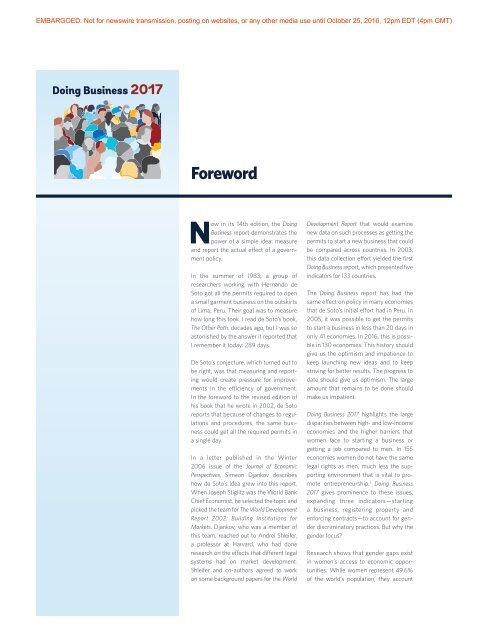49709doing-worldbank
49709doing-worldbank
49709doing-worldbank
You also want an ePaper? Increase the reach of your titles
YUMPU automatically turns print PDFs into web optimized ePapers that Google loves.
EMBARGOED: Not for newswire transmission, posting on websites, or any other media use until October 25, 2016, 12pm EDT (4pm GMT)<br />
Doing Business 2017<br />
Foreword<br />
Now in its 14th edition, the Doing<br />
Business report demonstrates the<br />
power of a simple idea: measure<br />
and report the actual effect of a government<br />
policy.<br />
In the summer of 1983, a group of<br />
researchers working with Hernando de<br />
Soto got all the permits required to open<br />
a small garment business on the outskirts<br />
of Lima, Peru. Their goal was to measure<br />
how long this took. I read de Soto’s book,<br />
The Other Path, decades ago, but I was so<br />
astonished by the answer it reported that<br />
I remember it today: 289 days.<br />
De Soto’s conjecture, which turned out to<br />
be right, was that measuring and reporting<br />
would create pressure for improvements<br />
in the efficiency of government.<br />
In the foreword to the revised edition of<br />
his book that he wrote in 2002, de Soto<br />
reports that because of changes to regulations<br />
and procedures, the same business<br />
could get all the required permits in<br />
a single day.<br />
In a letter published in the Winter<br />
2006 issue of the Journal of Economic<br />
Perspectives, Simeon Djankov describes<br />
how de Soto’s idea grew into this report.<br />
When Joseph Stiglitz was the World Bank<br />
Chief Economist, he selected the topic and<br />
picked the team for The World Development<br />
Report 2002: Building Institutions for<br />
Markets. Djankov, who was a member of<br />
this team, reached out to Andrei Shleifer,<br />
a professor at Harvard, who had done<br />
research on the effects that different legal<br />
systems had on market development.<br />
Shleifer and co-authors agreed to work<br />
on some background papers for the World<br />
Development Report that would examine<br />
new data on such processes as getting the<br />
permits to start a new business that could<br />
be compared across countries. In 2003,<br />
this data collection effort yielded the first<br />
Doing Business report, which presented five<br />
indicators for 133 countries.<br />
The Doing Business report has had the<br />
same effect on policy in many economies<br />
that de Soto’s initial effort had in Peru. In<br />
2005, it was possible to get the permits<br />
to start a business in less than 20 days in<br />
only 41 economies. In 2016, this is possible<br />
in 130 economies. This history should<br />
give us the optimism and impatience to<br />
keep launching new ideas and to keep<br />
striving for better results. The progress to<br />
date should give us optimism. The large<br />
amount that remains to be done should<br />
make us impatient.<br />
Doing Business 2017 highlights the large<br />
disparities between high- and low-income<br />
economies and the higher barriers that<br />
women face to starting a business or<br />
getting a job compared to men. In 155<br />
economies women do not have the same<br />
legal rights as men, much less the supporting<br />
environment that is vital to promote<br />
entrepreneurship. 1 Doing Business<br />
2017 gives prominence to these issues,<br />
expanding three indicators—starting<br />
a business, registering property and<br />
enforcing contracts—to account for gender<br />
discriminatory practices. But why the<br />
gender focus?<br />
Research shows that gender gaps exist<br />
in women’s access to economic opportunities.<br />
While women represent 49.6%<br />
of the world’s population, they account


